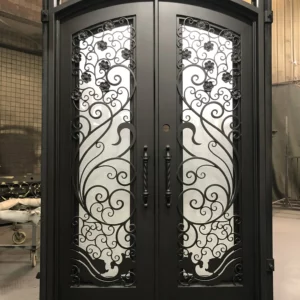After cleaning a wrought iron door, it’s important to take steps to protect it and maintain its appearance.
Here are some recommended steps to protect a wrought iron door:
Dry the Door: Ensure that the wrought iron door is thoroughly dried after cleaning. Moisture left on the surface can lead to rust or corrosion over time. Use towels or allow sufficient air drying time before applying any protective measures.
Apply a Protective Coating: Consider applying a protective coating or sealant to the cleaned wrought iron door. This can help prevent moisture penetration, inhibit rust formation, and provide a barrier against environmental elements. There are various types of protective coatings available, including clear polyurethane, rust-inhibiting paints, or specialized metal sealants. Follow the manufacturer’s instructions for application.
Touch up the Paint: If the wrought iron door is painted, check for any signs of chipping or peeling paint after cleaning. Touch up these areas with matching paint to protect the underlying metal from exposure and potential rusting. Ensure that the paint used is suitable for exterior use and provides adequate protection against the elements.
Apply Wax or Polish: Consider applying a wax or metal polish specifically formulated for wrought iron. These products can add an extra layer of protection, enhance the door’s shine, and make it easier to clean in the future. Follow the product instructions for application and buff the surface for a smooth finish.
Regular Maintenance: Establish a regular maintenance routine for the wrought iron door. Regularly inspect the door for signs of damage, rust, or deterioration. Clean the door as needed to remove dirt or grime. Promptly address any issues or areas requiring touch-ups to prevent further damage.
Avoid Harsh Chemicals or Abrasives: When cleaning or maintaining a wrought iron door, avoid using harsh chemicals, abrasive cleaners, or rough brushes. These can damage the surface, strip protective coatings, or scratch the metal. Opt for gentle cleaning agents and soft cloths or non-abrasive sponges for routine maintenance.
Keep the Surrounding Area Clean: Ensure that the area around the wrought iron door is kept clean and free from debris. Leaves, dirt, or other organic matter can accumulate and trap moisture against the door, leading to potential rust or corrosion. Regularly sweep or clean the surrounding area to maintain a clean environment.
By following these steps, you can help protect your wrought iron door and prolong its lifespan while preserving its aesthetic appeal.
What are some effective techniques for removing rust from a wrought iron door?
Removing rust from a wrought iron door requires specific techniques to effectively restore its appearance. Here are some effective techniques for rust removal from a wrought iron door:
Wire Brush or Steel Wool: Start by using a wire brush or steel wool to scrub the rusted areas. These tools can help loosen and remove surface rust. Ensure to use gentle pressure to avoid scratching or damaging the wrought iron surface.
Sanding: For more stubborn rust or areas with thicker rust buildup, sanding can be effective. Use sandpaper with a medium to fine grit to gently sand away the rust. This process helps smooth the surface and prepares it for further treatment.
Chemical Rust Removers: There are commercial rust removers available that can be applied to the affected areas. Follow the instructions provided with the product for application and safety guidelines. These rust removers typically contain chemicals that dissolve or convert rust, making it easier to remove.
Vinegar or Lemon Juice: Natural acids like vinegar or lemon juice can be used as homemade rust removal solutions. Soak a cloth or paper towel in vinegar or lemon juice and apply it to the rusted areas. Let it sit for some time to allow the acid to work on the rust. china wrought iron door cleaner supplier Then, scrub the area with a brush or cloth to remove the loosened rust.
Baking Soda Paste: Create a paste by mixing baking soda with water until it forms a thick consistency. Apply the paste to the rusted areas and let it sit for a while. Scrub the paste using a brush or cloth to remove the rust. Baking soda acts as a gentle abrasive and can help remove surface rust.
Rust Converters: Rust converters are chemical solutions designed to convert rust into a stable compound that can be painted over. Apply the rust converter to the affected areas according to the product instructions. As the rust converter reacts with the rust, it forms a protective coating that can be painted over.
Repainting: After removing the rust, consider repainting the wrought iron door to provide a fresh protective layer. Clean the surface thoroughly, apply a suitable primer, and follow it with a paint specifically formulated for metal surfaces. This helps prevent future rust formation and enhances the door’s appearance.
It’s important to note that rust removal techniques may vary depending on the severity of the rust and the specific condition of the wrought iron door. Always wear protective gloves and follow safety guidelines when working with rust removal products or chemicals.
